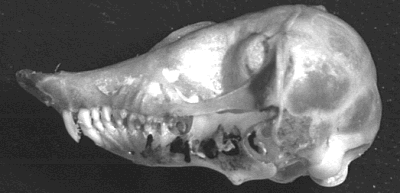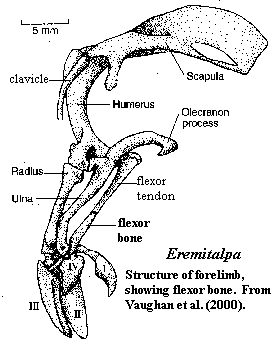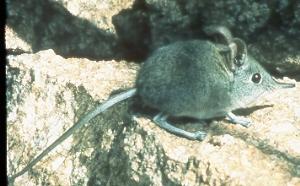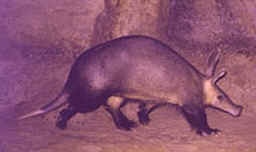 Chrysochloroidea: golden moles) Amblysomus, Chlorotalpa, Chrysochloris, Cryptochloris, Eremitalpa, Proamblysomus.
Chrysochloroidea: golden moles) Amblysomus, Chlorotalpa, Chrysochloris, Cryptochloris, Eremitalpa, Proamblysomus.| Afrotheria | ||
| The Vertebrates | Afrotheria |
| Vertebrates Home | Vertebrate | Vertebrate |
|
Abreviated Dendrogram
Eutheria
│
└─Afrotheria
├─Chrysochloroidea
├─Macroscelidea
└─┬─Tubulidentata
└─Paenungulata
├─Hyracoidea
└─┬─Sirenia
└─Proboscidea
|
Contents
|

Afrotheria: tenrecs, golden moles, aardvarks, hyraxes, sea cows, & elephants,
Fr upPc.
Phylogeny: Crown Group Placentalia : Boreoeutheria + Xenarthra + * : Chrysochloroidea + Macroscelidea + (Tubulidentata + Paenungulata)
Comments: one of the new mammalian clades proposed in the last decade or two based on analyses of DNA and other molecular sequence data are the Afrotheria, whose geographic origin inspired phylologists to designate a whole bunch of new clades included therein with an afro prefix. Includes the old Paenungulata plus a number of insectivores and insectivore-like forms, and the arrdvarks. These include Afrosoricida for Chrysochloroidea + Tenrecoidea; Afroinsectivora for Macroscelidea + Afrosoricida; and Afroinsectiphillia for Afroinsectivora + Aardvarks. These are generally favoured by molecular phylogeny, but there is rarely a scrap of morphological data to support them (Wikipedia lists high vertebral count (e.g. Golden Moles), features of placentation, shape of the ankle bones, and relatively late eruption of the permanent dentition, but compared to stamdard morphology analysis this is pretty thin). Nevertheless, the inclusion of two insectivore taxa is so bizarre from a morphological perspective that it prompted on of us to write a spirited criticism of this sort of application of molecular phylogeny. As far as the combined (total evidence) approach goes, parsimony analysis by Seiffert 2007 of 4,590 genomic and morphological characters across 16 extant and 35 extinct afrotherians recovered a monophyletic Afroinsectivora, consisting of Afrosoricida + Macroscelidea. On the other hand, Wible et al 2009's stem-eutherian based analysis rejects Afrosoricida and returns tenrics to the insectivores. Wible et al 2009 also makes insectivores stem Atlantogenata; (Afrotheria + Xenarthra). Perhaps insectivores are a paraphyletic rather than the polyphyletic assemblage accoridng to molecular morphology. Some insectivores would then be closer to a paraphyletic (according to Wible et al 2009) Boreoeutheria, others to the Afrotheria. MAK120319
Image by Microecos (and the immortal Bob Marley :-)
 Chrysochloroidea: golden moles) Amblysomus, Chlorotalpa, Chrysochloris, Cryptochloris, Eremitalpa, Proamblysomus.
Chrysochloroidea: golden moles) Amblysomus, Chlorotalpa, Chrysochloris, Cryptochloris, Eremitalpa, Proamblysomus.
Range: from the Miocene, always restricted to Sub-Saharan Africa [N99] [V+00].
Phylogeny:
Cladistic morphology: Insectivora : (Micropternodontidae + (Erinaceomorpha + Soricomorpha)) + *.;
Molecular and Total Approach: Afrotheria : Tubulidentata + Paenungulata + (Macroscelidea + Afrosoricida : Tenrecoidea + * ) Our phylogeny, incorporating both of above: Afrotheria : Macroscelidea + (Tubulidentata + Paenungulata) + *
Characters: head + body 8-24 cm [N99]; skull strongly conical, not flattened, with broad braincase [N99] [V+00]; nasals (?) & premaxillae form narrow, elongate snout, expanding distally into 2 processes for nose pad [N99]; rostrum covered by large leathery pad [N99] [V+00]; nostrils covered by flap on underside of snout [N99]; skull conical, broad at braincase & not constricted at orbits; eyes vestigial & totally covered by skin [N99] [V+00]; zygomatic arches formed by elongations of maxillae [MN93$] [V+00]; temporomandibular joint located posterodorsal to external ear [MN93$]; tabulars in occipital area [V+00$]; small ears hidden by fur; pinnae absent [V+00]; malleus greatly enlarged [V+00]; bulla formed from tympanic [V+00]; braincase not constricted between orbits [N99]; orbitosphenoid small [MN93]; dental formula 3/3, 1/1, 3/3, 2-3/2-3 [N99] [V+00]; diphyodont, with adult teeth emerging relatively late  [V+00]; teeth slightly separated [N99]; I1 enlarged [V+00] (compare [N99]: all? incisors enlarged); 2 lateral incisors, canine & 1st premolars caniniform [N99]; P/p 2-3 molariform, narrow & wedge-shaped, with bladelike medial half [N99]; molars zalambdodont [C88] [A+02]; molars with 2 lateral cusps & 1 medial cusp, enamel ridge on both sides of medial cusp; molars high-crowned, with lower crowns twice as high as uppers [N99]; hyoid articulates with dentary [MN93$]; have short tails, invisible within fur [N99]; anterior chest wall deeply recessed to provide more room for arm muscle [N99] [V+00]; forearms & claws short & powerful [V+00]; forelimbs not rotated as in moles, retaining palm-down orientation [V+00]; distal forelimb with a third element or flexor bone, probably an ossified flexor tendon (see image) [V+00]; digits 4/5 [N99]; strong reduction in number of phalanges [MN93$]; manus V absent; huge claw on manus III & sometimes II [N99]; tibia & fibula fused distally [N99]; pes with 5 webbed, sharply clawed digits & naked sole [N99]; both sexes with single urogenital opening (cloaca) [N99]; pelage with distinctive iridescent sheen, thick, with a dense, wooly underfur [N99]; nosepad used extensively in digging (unlike true moles) [N99]; found in sandy areas, plains & forests [N99]; may be torpid in colder months [N99].
[V+00]; teeth slightly separated [N99]; I1 enlarged [V+00] (compare [N99]: all? incisors enlarged); 2 lateral incisors, canine & 1st premolars caniniform [N99]; P/p 2-3 molariform, narrow & wedge-shaped, with bladelike medial half [N99]; molars zalambdodont [C88] [A+02]; molars with 2 lateral cusps & 1 medial cusp, enamel ridge on both sides of medial cusp; molars high-crowned, with lower crowns twice as high as uppers [N99]; hyoid articulates with dentary [MN93$]; have short tails, invisible within fur [N99]; anterior chest wall deeply recessed to provide more room for arm muscle [N99] [V+00]; forearms & claws short & powerful [V+00]; forelimbs not rotated as in moles, retaining palm-down orientation [V+00]; distal forelimb with a third element or flexor bone, probably an ossified flexor tendon (see image) [V+00]; digits 4/5 [N99]; strong reduction in number of phalanges [MN93$]; manus V absent; huge claw on manus III & sometimes II [N99]; tibia & fibula fused distally [N99]; pes with 5 webbed, sharply clawed digits & naked sole [N99]; both sexes with single urogenital opening (cloaca) [N99]; pelage with distinctive iridescent sheen, thick, with a dense, wooly underfur [N99]; nosepad used extensively in digging (unlike true moles) [N99]; found in sandy areas, plains & forests [N99]; may be torpid in colder months [N99].
Note: [1] in molecular analyses, Chrysochloroidea usually group with the tenrecs in the Afrotheria. [2] The orientation of the arms is consistent with a unique digging style, in which scraping with forelimbs alternates with pushing dirt with the extremely strong snout, braced on the forelimbs. [3] tend to live in dry soils or sands, with temporary tunnel systems, or simply using soil as a medium with out actual tunnel building.
Image: Skull of Chrysochloris asiaticus from the UMass Mammalogy Database.
Links: Chrysochloroidea Mikko's Phylogeny); 食虫目 Chinese: brief discussion of diversity); Animal Diversity Web: Chrysochloridae Family-- nice succinct description); Afrotherian systematics; mammsrch.phtml-family=Chrysochloridae U. Mass. Mammalogy database); Molecular evidence for multiple origins of Insectivora and for a ... Afrotheria); Untitled lecture notes).
References: Asher et al. 2002) [A+02]; Carroll (1988) [C88]; MacPhee & Novacek 1993) [MN93]; Nowak (1999) [N99]; Vaughan et al. 2000) [V+00]. ATW030711.
Comment: traditionally basal insectivores, now placed in the afrotheria on molecular, and even (Wible et al 2009) morphological evidence, so we've relocated them from their original taxonomic placement in the Insectivora. In any case, a better argument may be made for afrotherian golden moles then afrotherian tenrecs (the tenrecs being morphologically very deeply nested in the insectivora, would require a ridiculous degree of morphologolical convergence to be included in a molecular-sequencing based Afrosoricida. MAK120316
 Macroscelidea: elephant shrews: Elephantulus, Myohyrax, Nementchatherium, Rhynchocyon.
Macroscelidea: elephant shrews: Elephantulus, Myohyrax, Nementchatherium, Rhynchocyon.
fr upEc of Afr.
Afrotheria : Chrysochloroidea + (Tubulidentata + Paenungulata) + *.
40- 600g & 10-30 cm body length; cranial: long, flexible, very sensitive snout [N91]; nostrils at end of snout [N91]; palate with 2-3 paired fenestrae; (see macroscelidea.jpg) large jugal; zygomatic arch complete & slight; orbit large; small postorbital processes; no postorbital bar; small olfactory lobe; pinnae large; auditory bulla complete, with entotympanic bone and contributions from several other elements; dental: high-crowned teeth (hypsodont) with dilambdodont molars; dental formula: 1-3/3, 1/1, 4/4, 2/2-3 [N91]; I1s widely spaced [N91]; incisors form straight, anteroposterior row; posterior incisors caniniform; upper canine is double-rooted & molar-like; P4 is largest cheek tooth; molars quadrate; molars dilambdodont [N91]; last molar (m3? M2?) reduced & vestigial; chew by grinding as rabbits; tail 8-25 cm [N91]; axial: tail with species-specific bristles [N91]; tail with sexually dimorphic scent-marking gland on underside [N91]; appendicular: limbs long and slim; digits 5/4-5 [N91]; ulna and radius closely appressed; hind limbs much longer than forelimbs [N91]; tibia & fibula fused; highly adapted for cursorial (saltatorial?) locomotion; cecum present; polyovulate, with up to 120 eggs per ovulation, but only 2 fertilized eggs implant; abdominal testes; other: carnivorous or insectivorous (from ground litter); live in plains or less commonly forest, rocky outcrops; generally monogamous; most are solitary or pair-bonded (1 species social) [N91]; territorial with scent marking and fixed trails, ritualized aggression displays; territories defended sex-specifically (males v. males etc.); gestation ~60 dy [N91]; young are precocial, with sexual maturity in 5-6 weeks [N91].
Links: Elephant Shrew Skull; EL-SHRWS; Animal Diversity Web: Order Macroscelidea: Family Macroscelididae; Lecture 12 - Mac/Der/Scan.; Macroscelidea; Elephant Shrew - Elephantulus rufescens; septhreo.html; Rüsselspringer German); JBC -- Graham et al. 271 (26): 15623; Macroscelidea after Tabuce, et al., 2001; Elephant Shrews - Order Macroscelidea; Macroscelidea; Comparative Mammalian Brain Collections: Macroscelidea; Tanzanian Mammal Key; Elephant-Shrews important site, perhaps Best on the Web).
References: Nowak 1991: 180-181) [N91].
Note: May be an odd, diminutive branch of the African ungulate radiation, insectivores, scandentians, or (as here) sister to rabbits. ATW011220 Now placed in the afrotheria on molecular evidence MAK120316
 Tubulidentata: aardvarks Archaeorycteropus, Leptorycteropus, Myorycteropus, Orycteropus, Palaeorycteropus, Plesiorycteropus.
Tubulidentata: aardvarks Archaeorycteropus, Leptorycteropus, Myorycteropus, Orycteropus, Palaeorycteropus, Plesiorycteropus.
From the Early Miocene of Europe and Africa.
Phylogeny: Afrotheria : Chrysochloroidea + Macroscelidea + (Paenungulata + *).
Skull elongate & conical; thin, protrusible tongue; dentary elongate and slender, bladelike anteriorly & wider at molars; elaborate turbinals and highly-developed olfactoray centers of brain; nares can be sealed with hair; small tentacular (chemosensory?) structures on nares; zygomatic arch complete; poor vision; palate ends at the posterior end of the palatines & is not extended posteriorly by the pterygoid (see tubulidentata.jpg from the ADW); auditory pinnae long and pointed; dental formula (adult) 0/0, 0/0, 2-3/2, 3/3; teeth rootless and ever-growing, without enamel, columnar, and made up of ~100µ hexagonal prisms of dentine and pulp core; teeth surrounded by cementum; zygapophyses well-developed and interlocked; moderately long, muscular tail; very powerful forelimbs; digits 4/5, with long, spatulate claws; exceptionally fast digging ability; digitigrade, but slow locomotion; thick skin, almost hairless; insectivores, largely by digging for social insects; solitary; low basal metabolism and slightly lower than expected temperature (34.5°); nocturnal.
Commment: various paired with with Afroinsectivora as clade Afroinsectiphilia (Asher et al 2009); with Macroscelids only (Wible et al 2007, 2009), and with Paenungulates as clade Pseudoungulata (Seiffert 2007) MAK120317
Links: Animal Diversity Web: Order Tubulidentata; Aardvarks!; Tubulidentata; Order Tubulidentata: Aardvark; Comparative Mammalian Brain Collections: TUBULIDENTATA; Tubulidentata; Tubulidentata; tubulidentata page; Order Tubulidentata; Aardvark - Wikipedia; TUBULIDENTATA; ORYCTEROPODIDAE: Aardvark, or Ant Bear; Aardvark; Google Directory - Science >n; Biology >n; Flora and Fauna >n; Animalia ...; Aardvarks (Tubulidentata) - MavicaNET. ATW031107.
checked ATW040118 (Macroscelidea), 050623 ( Chrysochloroidea + Tenrecoidea), 050727 (Tubulidentata). Revised MAK120319; external links haven't been checked or updated